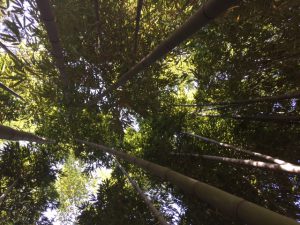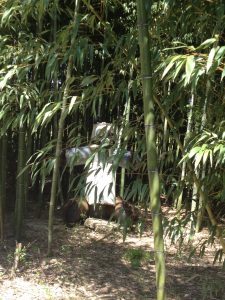Standing in the midst of a stand of bamboo, it’s easy to feel dwarfed. Smooth and sturdy, the hollow, sectioned woody shoots of this fascinating plant can tower as tall as 70 feet. Unfortunately, bamboo is a real threat to natural ecosystems, moving quickly through wooded areas, wetlands, and neighborhoods, taking out native species as it goes.
We do have one native species referred to as bamboo or cane (Arundinaria gigantea), which is found in reasonable numbers in southeastern wetlands and the banks of rivers. There are over a thousand species of true bamboo, but chief among the invasive varieties that give us trouble is Golden Bamboo (Phyllostachys aurea). Grown in its native Southeast Asia as a food source, building material, or for fishing rods, bamboo is also well known as the primary diet (99%) of the giant panda. In the United States, the plant was brought in as an ornamental—a fast growing vegetative screen that can also be used as flooring material or food. Clumping bamboos can be managed in a landscape, but the invasive, spreading bamboo will grow aggressively via roots and an extensive network of underground rhizomes that might extend more than 100 feet from their origin.
As a perennial grass, bamboo grows straight up, quickly, and can withstand occasional cutting and mowing without impacts to its overall health. However, a repeated program of intensive mowing, as often as you’d mow a lawn and over several years, will be needed to keep the plant under control. Small patches can be dug up, and there has been some success with containing the rhizomes by installing an underground “wall” of wood, plastic, or metal 18” into the soil around a section of bamboo.
While there are currently no chemical methods of control specifically labeled for bamboo at this time, the herbicides imazapyr (trade name Arsenal and others) or glyphosate (Round-up, Rodeo) applied at high rates can control it. According to research on the topic, “bamboo should be mowed or chopped and allowed to regrow to a height of approximately 3 feet, or until the leaves expand. Glyphosate at a 5% solution or imazapyr as a 1% solution can then be applied directly to the leaves.” These treatments will often need to be repeated as many as four times before succeeding in complete control of bamboo.
Land managers should know that while imazapyr is typically a more effective herbicide for bamboo, it can kill surrounding beneficial trees and shrubs due to its persistence in the contiguous roots and soil. In contrast, glyphosate solutions will only kill the species to which it has been applied and is the best choice for most areas managed by homeowners.
Bamboo Control: http://edis.ifas.ufl.edu/pdffiles/AG/AG26600.pdf
- Hurricane Season 2025 - July 7, 2025
- The Striped Burrfish - April 11, 2025
- The Value of Biodiversity - March 28, 2025


